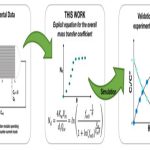Bedingfield and Drew (1950) studied the sublimation from a solid cylinder into air which is flowing normal to its axis. They developed a correlation for the mass transfer coefficient from their experimental data which can be represented as:

In this case the Reynolds number is defined based on the diameter of the cylinder. Gm is the molar mass velocity of the gas and P is the total pressure. The correlation is applicable in the range of 400 < Re < 25000 and 0.6 < Sc < 2.6.
Correlation of mass transfer coefficients in circular pipes
In a wetted wall towers as shown in Figure 3.1, the mass transfer from the thin liquid film in the tube wall from the moving fluid has been studied extensively. In the tower a volatile pure liquid flows down inside the surface of the tube wall where a gas is allowed to pass through the central core. Here the evaporation of the liquid into the moving gas stream through the gas liquid surface is referred as mass transfer from liquid to gas Gilliland and Sherwood (1934) developed the following correlation from the experimental data obtained by using different liquid and air as gas in the range of 2.0×103 < Re < 3.50×103 and 0.6 < Sc < 2.5

where the physical properties of the gas are evaluated at the bulk conditions of the moving gas. Sherwood number and Reynolds number are based on tower diameter. Linton and Sherwood (1950) studied the mass transfer by extending the Schmidt number. They developed a correlation with the extended data set and the data set of Gilliland and Sherwood which can be represented as:



